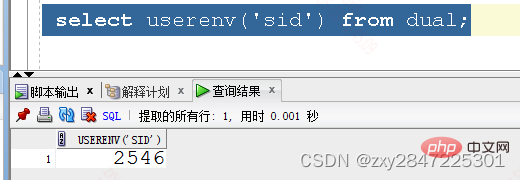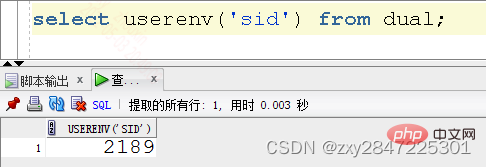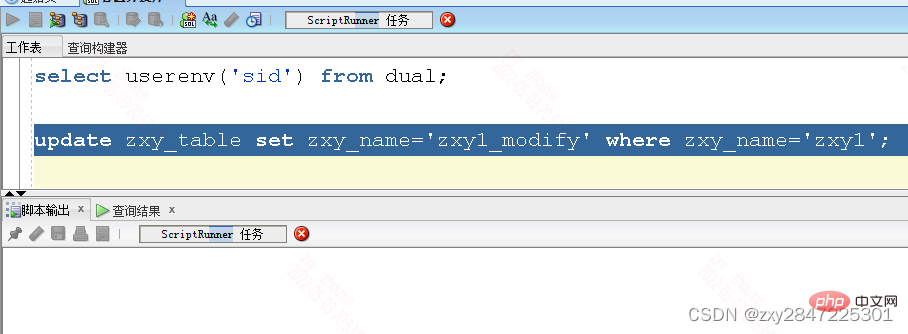oracle view lock and session execution sql (summary sharing)
This article brings you relevant knowledge about Oracle, which mainly introduces the issues related to checking locks and sql in session execution. Let’s take a look at it together. I hope it will be helpful to everyone. .

Recommended tutorial: "Oracle Video Tutorial"
The database environment for the test data in this article: Oracle 11g
Why is it said that it is the sql during session execution? It seems that the sql execution record of a certain session cannot be obtained. I have also read a lot of blog posts. Many people on the Internet say that the sql_id is associated with the view v$active_session_history and v$sqlarea. You can query the sql execution record of a certain session. After practice, it is found that it does not work (tried through the table dba_hist_active_sess_history also does not work) , the sql_id of some sql is not recorded at all in v$active_session_history, I Try to modify the parameters: control_management_pack_access, and found that I do not have permission. I checked it and found that the parameter value is normal and the parameter database is open. Refer to the blog post: Oracle V$ACTIVE_SESSION_HISTORY Query No Data - wazz_s - Blog Park
I can query the execution record of SQL through the v$sqlarea view, but I cannot find the sessionid that executed the SQL. It would be great if I had this sessionid, so that I can find out who executed the SQL. .
If I want to query the sql that caused the table to be locked, most of the blog posts on the Internet teach this. Get the corresponding prev_sql_addr field value by querying the view v$session, which is recorded as Value A, and then use value A as the query condition value of the view v$sqlarea field address, and then the corresponding SQL record can be queried. As a practice test, you can find the SQL that finds the lock table, but in most cases you cannot get it in a normal production environment. Why? Please see the introduction below.
This article uses an exploratory approach to study. In order to ensure the accuracy of the data, I opened three database sessions, recorded as session1, session2, and session3 respectively. The specific steps are as follows:
1 Create a new test table and test data in session session1
--新建测试表 create table zxy_table(zxy_id int,zxy_name varchar2(20)); --插入数据 insert into zxy_table(zxy_id,zxy_name) values(1,'zxy1'); insert into zxy_table(zxy_id,zxy_name) values(2,'zxy2'); insert into zxy_table(zxy_id,zxy_name) values(3,'zxy3'); insert into zxy_table(zxy_id,zxy_name) values(4,'zxy4'); commit;
2 View the session ID of session1
select userenv('sid') from dual; 
You can see that the session ID is 2546
3 In session1, lock a row of the table zxy_table through select for update, as follows:
select * from zxy_table where zxy_name='zxy1' for update;
4 In session2, query that the session ID is 2189:

Then update the row in the table zxy_table with the value zxy_name='zxy1' in session2, as follows:
update zxy_table set zxy_name='zxy1_modify' where zxy_name='zxy1';
Then we saw that the sql has been blocked, as shown below:

5 Then we came to session 3 to view the lock table situation
First check the table v$locked_object
select * from v$locked_object;

You can see that the session id that caused the lock table is 2546, which is the previous session1, and the object_id is 110154. Of course, In the generation environment, you will definitely see more than one record. You have to execute it several times. After executing it n times, you can still see the record, which proves that this record is the record of the lock table.
Pass object_id :110154 Query the dba4_objects table to query the detailed lock table information
select object_name as 被锁的表名称,obj.* from dba_objects obj where object_id='110154';

select s.prev_sql_addr, module as 客户端工具名称, s.user# as 数据库账号名, s.osuser as 连接数据库客户端对应的window账号名称, s.machine as 连接数据库客户端对应的计算机名称, s.* from v$session s where sid='2546';
 ## Get the value of prev_sql_addr: 000000012E045E28, and then query the view v$sqlarea through the obtained value
## Get the value of prev_sql_addr: 000000012E045E28, and then query the view v$sqlarea through the obtained value
select * from v$sqlarea where address='000000012E045E28';
 As you can see from the picture above, the result There is a statement to lock the table, but many blog posts are finished at this step. Is this query really reliable? The answer is unreliable. You can go back to session1 and execute a sql at will, as follows:
As you can see from the picture above, the result There is a statement to lock the table, but many blog posts are finished at this step. Is this query really reliable? The answer is unreliable. You can go back to session1 and execute a sql at will, as follows:
select * from zxy_table;
Then you can go to session3 to execute
select s.prev_sql_addr, module as 客户端工具名称, s.user# as 数据库账号名, s.osuser as 连接数据库客户端对应的window账号名称, s.machine as 连接数据库客户端对应的计算机名称, s.* from v$session s where sid='2546';
再看看prev_sql_addr是不是变了,从000000012E045E28变为了00000001FB03CEC0,再通过00000001FB03CEC0查询视图v$sqlarea
select * from v$sqlarea where address='00000001FB03CEC0';

得到的sql_text是select * from zxy_table,你敢说这条sql导致了锁表吗?所有只能说是session1当前执行的sql,而且你很难保证session1执行完锁表的sql: select * from zxy_table where zxy_name='zxy1' for update且在提交前不再执行别的sql,这就是前文提出的问题的答案。
推荐教程:《Oracle视频教程》
The above is the detailed content of oracle view lock and session execution sql (summary sharing). For more information, please follow other related articles on the PHP Chinese website!

Hot AI Tools

Undresser.AI Undress
AI-powered app for creating realistic nude photos

AI Clothes Remover
Online AI tool for removing clothes from photos.

Undress AI Tool
Undress images for free

Clothoff.io
AI clothes remover

Video Face Swap
Swap faces in any video effortlessly with our completely free AI face swap tool!

Hot Article

Hot Tools

Notepad++7.3.1
Easy-to-use and free code editor

SublimeText3 Chinese version
Chinese version, very easy to use

Zend Studio 13.0.1
Powerful PHP integrated development environment

Dreamweaver CS6
Visual web development tools

SublimeText3 Mac version
God-level code editing software (SublimeText3)

Hot Topics
 1664
1664
 14
14
 1421
1421
 52
52
 1315
1315
 25
25
 1266
1266
 29
29
 1239
1239
 24
24
 What to do if the oracle can't be opened
Apr 11, 2025 pm 10:06 PM
What to do if the oracle can't be opened
Apr 11, 2025 pm 10:06 PM
Solutions to Oracle cannot be opened include: 1. Start the database service; 2. Start the listener; 3. Check port conflicts; 4. Set environment variables correctly; 5. Make sure the firewall or antivirus software does not block the connection; 6. Check whether the server is closed; 7. Use RMAN to recover corrupt files; 8. Check whether the TNS service name is correct; 9. Check network connection; 10. Reinstall Oracle software.
 How to solve the problem of closing oracle cursor
Apr 11, 2025 pm 10:18 PM
How to solve the problem of closing oracle cursor
Apr 11, 2025 pm 10:18 PM
The method to solve the Oracle cursor closure problem includes: explicitly closing the cursor using the CLOSE statement. Declare the cursor in the FOR UPDATE clause so that it automatically closes after the scope is ended. Declare the cursor in the USING clause so that it automatically closes when the associated PL/SQL variable is closed. Use exception handling to ensure that the cursor is closed in any exception situation. Use the connection pool to automatically close the cursor. Disable automatic submission and delay cursor closing.
 How to create cursors in oracle loop
Apr 12, 2025 am 06:18 AM
How to create cursors in oracle loop
Apr 12, 2025 am 06:18 AM
In Oracle, the FOR LOOP loop can create cursors dynamically. The steps are: 1. Define the cursor type; 2. Create the loop; 3. Create the cursor dynamically; 4. Execute the cursor; 5. Close the cursor. Example: A cursor can be created cycle-by-circuit to display the names and salaries of the top 10 employees.
 What steps are required to configure CentOS in HDFS
Apr 14, 2025 pm 06:42 PM
What steps are required to configure CentOS in HDFS
Apr 14, 2025 pm 06:42 PM
Building a Hadoop Distributed File System (HDFS) on a CentOS system requires multiple steps. This article provides a brief configuration guide. 1. Prepare to install JDK in the early stage: Install JavaDevelopmentKit (JDK) on all nodes, and the version must be compatible with Hadoop. The installation package can be downloaded from the Oracle official website. Environment variable configuration: Edit /etc/profile file, set Java and Hadoop environment variables, so that the system can find the installation path of JDK and Hadoop. 2. Security configuration: SSH password-free login to generate SSH key: Use the ssh-keygen command on each node
 What to do if the oracle log is full
Apr 12, 2025 am 06:09 AM
What to do if the oracle log is full
Apr 12, 2025 am 06:09 AM
When Oracle log files are full, the following solutions can be adopted: 1) Clean old log files; 2) Increase the log file size; 3) Increase the log file group; 4) Set up automatic log management; 5) Reinitialize the database. Before implementing any solution, it is recommended to back up the database to prevent data loss.
 Oracle's Role in the Business World
Apr 23, 2025 am 12:01 AM
Oracle's Role in the Business World
Apr 23, 2025 am 12:01 AM
Oracle is not only a database company, but also a leader in cloud computing and ERP systems. 1. Oracle provides comprehensive solutions from database to cloud services and ERP systems. 2. OracleCloud challenges AWS and Azure, providing IaaS, PaaS and SaaS services. 3. Oracle's ERP systems such as E-BusinessSuite and FusionApplications help enterprises optimize operations.
 How to stop oracle database
Apr 12, 2025 am 06:12 AM
How to stop oracle database
Apr 12, 2025 am 06:12 AM
To stop an Oracle database, perform the following steps: 1. Connect to the database; 2. Shutdown immediately; 3. Shutdown abort completely.
 How to export oracle view
Apr 12, 2025 am 06:15 AM
How to export oracle view
Apr 12, 2025 am 06:15 AM
Oracle views can be exported through the EXP utility: Log in to the Oracle database. Start the EXP utility, specifying the view name and export directory. Enter export parameters, including target mode, file format, and tablespace. Start exporting. Verify the export using the impdp utility.




